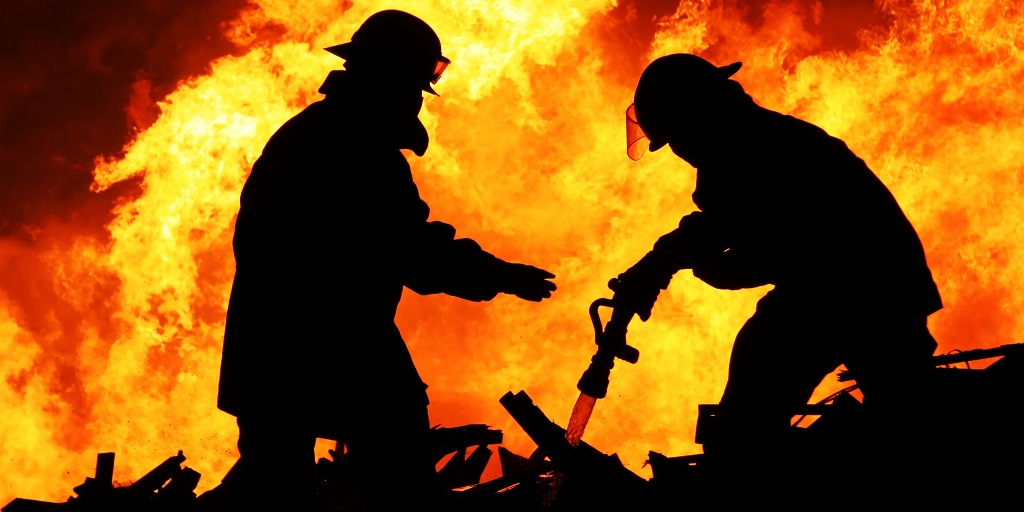On Monday night, 39 migrants died, and another 27 were seriously injured, in a fire in a Mexican detention center in Ciudad Juarez. The migrants—most of them from Guatemala, El Salvador, Honduras, and Venezuela—were being held for deportation by the Mexican immigration enforcement agency INM, after a sweep to pick up migrants who were working as street vendors.
When the fire started, according to Mexican government officials, 68 migrants had been held for hours without water in a space designed to hold no more than 50. Initial reports from Mexican authorities blamed migrants for starting the fire by setting fire to their mattresses in protest (a claim disputed by the survivors). Security footage of the facility shows guards walking past a locked cell through the smoke, ignoring the people inside.
The loss of life is tragic. But if a tragedy implies something private and unique, disconnected from broader social forces and with barely anyone to blame, this isn’t that. The migrants who died in Juarez on Monday were failed by both the U.S. and Mexican governments, which have spent the last three years telling them not to stay without giving them anywhere to go.
Shelters and communities along the Mexican side of the border have borne the weight of U.S. policies, like Title 42, that rapidly expel migrants to Mexico or force them to wait for limited opportunities to seek asylum. The pressure on these shelters and communities has only increased as the U.S. government prepares to lift the federal state of emergency due to the COVID-19 pandemic—with Title 42 expected to end and normal immigration processing to resume again. But the policy reality facing migrants is far more complicated than “now the border is closed, but in May it will be open.” As survivors of the fire attested in a protest on Tuesday night, their hopes have been raised only to be dashed again—leaving them all the more disempowered, frustrated, and desperate.
Right now, with the Title 42 order in effect, any Central American adult or family who crosses into the U.S. between official ports of entry can be expelled back to Mexico without a chance to seek asylum. In practice, Border Patrol agents are only expelling some, and subjecting others to standard immigration processing (and potential deportation). The same is now true for thousands of Venezuelans, who the Mexican government agreed to start accepting last fall; and Cubans, Nicaraguans, and Haitians, who Mexico has accepted since January. In theory, these nationalities are eligible to apply to enter the U.S. legally for two years under a parole program, but this policy does nothing to help migrants without family in the U.S., available savings for airfare, and other advantages. And some migrants can seek exemptions from Title 42 by scheduling appointments at the official port of entry—but appointments are so limited, and the CBP One app through which they’re allocated is so unreliable, that it seems like a false promise to migrants like the ones stuck in Juarez.
Making matters even more complicated, before Title 42 is lifted, the U.S. government plans to put into place a new regulation that would all but bar asylum to migrants who cross between ports of entry if they traveled through another country (unless they applied for asylum there and were rejected) before arriving. This would apply to every migrant in the Juarez facility, and others like them. The only way for them to seek asylum will likely be to make appointments via the same CBP One app that is already causing border-wide dysfunction.
In the meantime, they’re biding their time on the Mexican side of the border—as thousands of U.S.-bound migrants have for years, first under metering, then under the Migrant Protection Protocols (“Remain in Mexico”) policy which forced them to leave the U.S. while awaiting court hearings, and now under the Title 42 expulsion policy.
During this time, the Mexican government has paid lip service to the need to care for migrants and ensure they can support themselves and live safely while they’re on Mexican soil. But it’s also stepped up its immigration enforcement, via the National Guard as well as INM. The United States, for its part, has failed to ask too many questions about how migrants are treated in Mexico. On Tuesday, when a State Department spokesperson was asked if the United States trusted Mexican facilities to keep migrants safe, the spokesperson deferred to Mexico—as if the United States couldn’t have its own opinion on the subject, and as if the U.S. government weren’t about to impose a policy that assumes Mexico is a safe place to seek asylum.
Arguably, both the U.S. and Mexican governments had a responsibility to the migrants who died Monday, and to those who survive. They were there as a result of U.S. policy, which continues to offer them no real path toward asylum. And they were on Mexican territory and in government custody. But neither government has been willing to take responsibility for them or the thousands like them along the border.
The cell that burned in Juarez was overcrowded not just because agents rounded up more migrants than they could safely hold, but because no government—neither the Mexican one nor the U.S.—has taken responsibility for where migrants live anywhere other than placing them behind bars.
FILED UNDER: México, Title 42


